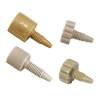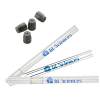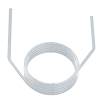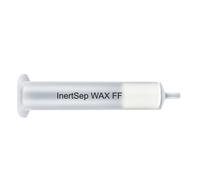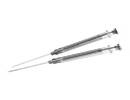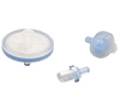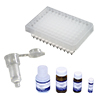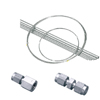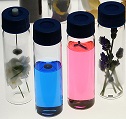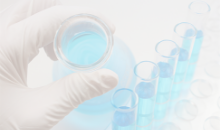Basics of Gas Chromatography
4-1 Distorted peak shapes
Analytical problems can be caused by factors other than instrument failure, such as errors in the column-handling methods and inappropriate analysis conditions. The following troubleshooting guide summarizes the common problems occurring in GC analysis (mainly when using capillary columns) and their possible solution methods. The two major problem categories are peak-shape-related problems and baseline-related problems, which should be tackled based on the chromatogram information obtained by the analysis. The troubleshooting guide also provides a reference checklist for the daily inspections of column performance, which can prevent problems before they occur.
9 points were indicated: tailing, leading, peak splitting, retention time shift, peak undetected, overall small peak, Poor repeatability, ghost peak carryover, and deterioration of column performance.
Tailing

|
Main Causes
|
Approach
|
|
Column disconnection failure
Improper column attachment position to inlet and detector |
Cut the column tip vertically with a dedicated column cutter (see Handling Capillary Columns).
Check the column insertion length. The cut position should match that specified in the instruction manual of the employed device. |
|
Liner contamination or deterioration
|
Clean or replace the liner. Depending on the specimen, consider selecting a liner with or without wool or changing the wool material.
|
|
Contamination of column (liquid phase)
|
Conditioning of columns.
Cut 50 cm off the inlet side of the column. |
|
Small split ratio
|
Increase the split ratio.
|
|
Incompatibility between column (liquid phase) and solvent
|
Change column (liquid phase) or solvent to match polarity. Use a retention gap (see capillary column-handling instructions).
|
|
Incompatibility between column (liquid phase) and sample
|
When targeting highly polar components, select a liquid phase with high polarity (see How to Select a Capillary Column).
|
|
Degradation of column (liquid phase)
|
Replace the column.
|
Fronting

|
Main Causes
|
Approach
|
|
Sample load of column (liquid phase) is exceeded
|
Adjust the introduction volume by reducing the injection volume, increasing the split ratio, or some similar action that reduces the load to below the sample loading of the column (liquid phase). Change to a column with a thicker membrane and increase the column (liquid phase) sample load.
|
|
Incompatible polarities of column (liquid phase) and sample
|
Select a column (liquid phase) that matches the polarity of the analyte.
|
Split peaks

|
Main Causes
|
Approach
|
|
Inappropriate injection conditions
|
Manual injection incurs a risk of improper injection speed or a faulty syringe. Change syringes or use an autosampler.
|
|
Improper column attachment position to the inlet
|
Adjust the column insertion length to match the position specified in the instruction manual of the GC system.
|
|
Solvent (sample) is a mixed solvent
|
May occur with splitless or on-column injections. Change to a single solvent.
|
|
Column (liquid phase) and solvent (sample) are incompatible
|
Change the column (liquid phase) or solvent to match the polarity. Use a retention gap (see Sample Injection Methods).
|
Retention time shifts
|
Main Causes
|
Approach
|
|
Carrier gas leakage
|
Check for leaks, mainly around the inlet and at the column connection. If the inlet septum is leaking, replace the septum.
|
|
Column (liquid phase) and solvent (sample) are incompatible
|
Change column (liquid phase) or solvent to match the polarity. Use a retention gap (see Sample Injection Methods).
|
|
Degradation of column (liquid phase)
|
Replace the column.
|
|
Clogged piping, flow regulator failure
|
If the split vent is blocked, clean or replace it. If the flow regulator fails, replace it.
|
|
Carrier gas supply shortage
|
Check the supply pressure to the GC; it may be inadequate.
|
No peaks at all

|
Main Causes
|
Approach
|
|
Defective syringe
|
Clean and replace the syringes.
|
|
Improper column attachment position to the inlet and detector
|
Adjust the column insertion length to the position specified in the instruction manual of the GC system.
|
|
Column breakage
|
Check for broken columns.
|
|
Carrier gas leakage, insufficient supply
|
Check for gas leaks, mainly around the inlet. If the inlet septum is leaking, replace the septum. Check for proper supply flow rate at the detector outlet, column outlet, etc.
|
|
Detector abnormality
|
Check the condition of the detector. Check for filament breakage in the MS and TCD and frame ignition in the FID. Check the cables connecting the detector to the data processor.
|
All peaks reduced in size

|
Main Causes
|
Approach
|
|
Partial syringe blockage
|
Clean and replace the syringes.
|
|
Leakage from inlet
|
Check for leakage from the inlet. If the inlet septum is leaking, replace the septum.
|
|
Large split ratio
|
Optimize the split ratio.
|
|
Insufficient sampling time
(in splitless injection) |
Ensure that the injection is splitless at the time of injection. Optimize the sampling time.
|
|
Problem with the sample
|
Check the concentration, stability, and other properties of the sample and reconsider the sample preparation and storage methods.
|
|
Inlet temperature too low
(especially when analyzing the high boiling–point components) |
Check and optimize the inlet temperature.
|
|
Inadequate combination of the components to be measured and the detector
|
Check whether the detector is appropriate. Detectors with high selectivity might not be detected.
|
|
Misconfigured detector or integrator
|
Check whether the sensitivity setting of the detector is correct. Check that the attenuation setting of the integrator is correct.
|
Poor Reproducibility
|
Main Causes
|
Approach
|
|
Carrier gas leakage, insufficient supply
|
Check for gas leaks, mainly around the inlet. If the inlet septum is leaking, replace the septum. Check for proper supply flow rate at detector outlet, column outlet, etc.
|
|
Inappropriate injection conditions
|
Select a liner that is appropriate for the injection method and volume. If injecting manually, use an autosampler, as manual injection may be the cause of the discrimination.
|
|
Syringe failure, autosampler-setting condition failure
|
Some samples have not been collected. Clean and replace the syringes. For highly viscous samples, consider slowing down the syringe aspiration rate.
|
|
Liner contamination and deterioration
|
Clean or replace the liner. Depending on the specimen, consider selecting a liner with or without wool, or changing the wool material.
|
|
Contamination of column (liquid phase)
|
Conditioning of columns. Cut 50 cm off the inlet side of the column. If there is no improvement, replace the column.
|
|
Unstable split ratio
|
If the split ratio is excessively small, the split ratio is not stable. Adjust to the appropriate split ratio for the column and instrument.
|
|
Detector failure
|
Check the condition of the detector.
|
Ghost Peak Carryover
|
Main Causes
|
Approach
|
|
Residue in column (insufficient column conditioning, residual high boiling–point components)
|
If irregularities are detected and the peak width is broad, column residues are probably present. Often improved by column conditioning, but in some cases, around 50 cm must be cut from the inlet side of the column. If the cause is a high boiling–point component in the sample, change the oven-temperature-rise conditions to elute the sample.
|
|
Contamination of vials, caps (septums), and syringes
|
If the syringe is contaminated, clean or replace it. If the same vial is analyzed continuously, the septum is probably contaminated and should be replaced.
|
|
Inlet contamination
|
May be caused by liner contamination from inlet septum debris or sample residue. Clean or replace the liner. Replace the inlet septum.
|
|
Injection volume is too large
|
Depending on the injection volume, liner size, septum purge flow rate, and inlet temperature conditions, the sample may overflow from the liner, causing carryover. Select the appropriate injection conditions.
|
Decreased Column Performance
|
Main Causes
|
Approach
|
|
Insufficient purity of carrier gas
(moisture and enzymes in carrier gas) |
Columns (liquid phase) can rapidly degrade when temperature is increased in the presence of water and oxygen. Install a moisture removal filter and oxygen removal filter in the carrier gas line. If these filters are already installed, please replace the filters into new ones.
|
|
Insufficient purging during column conditioning
|
Before use (before raising the temperature), thoroughly purge the column with a carrier gas and condition the column under the recommended conditions. (See capillary column-handling instructions).
|
|
The introduced samples cause chemical damage to the column (liquid phase)
|
If the sample contains an inorganic base (KOH, NaOH, etc.), inorganic acid (HCI, HNO3, HF, etc.), perfluoroacetic acid (CF3COOH, C2F5COOH, etc.), salt, or another matrix that adversely affects the column (liquid phase), consider pretreatment or other methods.
|
|
Insufficient sample cleanup
|
If the sample contains a matrix that adversely affects the column (liquid phase), consider pretreatment, etc.
|
|
Inadequate analytical conditions
|
Pay special attention to the final temperature setting of the temperature increase in the column oven program. The heat resistance temperature of the column must not be exceeded.
|


